Reconstructing the Nonlinear Filter Function of LILI-128 Stream Cipher Based on Complexity
- 格式:pdf
- 大小:124.14 KB
- 文档页数:6
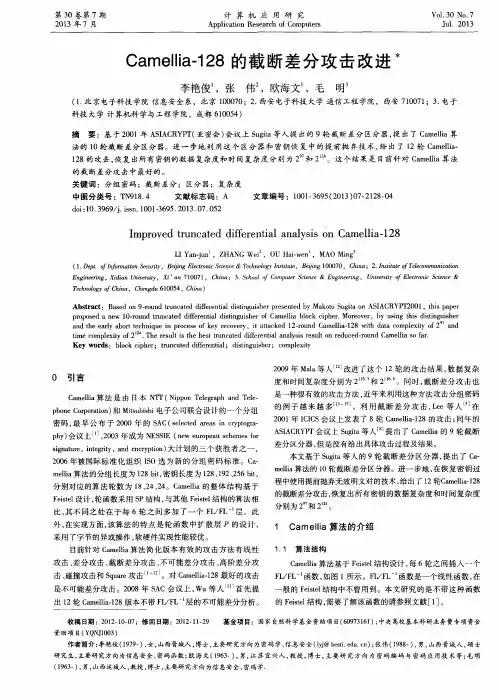
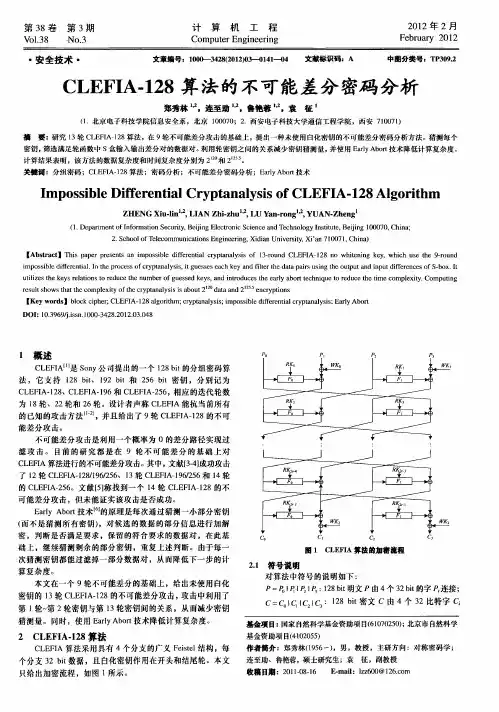
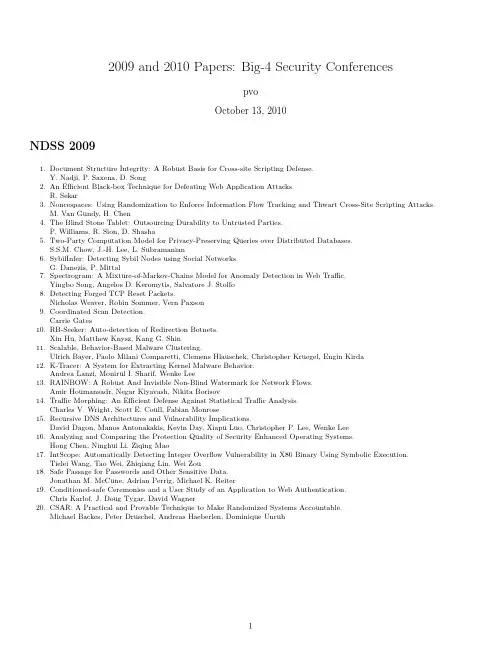
2009and2010Papers:Big-4Security ConferencespvoOctober13,2010NDSS20091.Document Structure Integrity:A Robust Basis for Cross-site Scripting Defense.Y.Nadji,P.Saxena,D.Song2.An Efficient Black-box Technique for Defeating Web Application Attacks.R.Sekar3.Noncespaces:Using Randomization to Enforce Information Flow Tracking and Thwart Cross-Site Scripting Attacks.M.Van Gundy,H.Chen4.The Blind Stone Tablet:Outsourcing Durability to Untrusted Parties.P.Williams,R.Sion,D.Shasha5.Two-Party Computation Model for Privacy-Preserving Queries over Distributed Databases.S.S.M.Chow,J.-H.Lee,L.Subramanian6.SybilInfer:Detecting Sybil Nodes using Social Networks.G.Danezis,P.Mittal7.Spectrogram:A Mixture-of-Markov-Chains Model for Anomaly Detection in Web Traffic.Yingbo Song,Angelos D.Keromytis,Salvatore J.Stolfo8.Detecting Forged TCP Reset Packets.Nicholas Weaver,Robin Sommer,Vern Paxson9.Coordinated Scan Detection.Carrie Gates10.RB-Seeker:Auto-detection of Redirection Botnets.Xin Hu,Matthew Knysz,Kang G.Shin11.Scalable,Behavior-Based Malware Clustering.Ulrich Bayer,Paolo Milani Comparetti,Clemens Hlauschek,Christopher Kruegel,Engin Kirda12.K-Tracer:A System for Extracting Kernel Malware Behavior.Andrea Lanzi,Monirul I.Sharif,Wenke Lee13.RAINBOW:A Robust And Invisible Non-Blind Watermark for Network Flows.Amir Houmansadr,Negar Kiyavash,Nikita Borisov14.Traffic Morphing:An Efficient Defense Against Statistical Traffic Analysis.Charles V.Wright,Scott E.Coull,Fabian Monrose15.Recursive DNS Architectures and Vulnerability Implications.David Dagon,Manos Antonakakis,Kevin Day,Xiapu Luo,Christopher P.Lee,Wenke Lee16.Analyzing and Comparing the Protection Quality of Security Enhanced Operating Systems.Hong Chen,Ninghui Li,Ziqing Mao17.IntScope:Automatically Detecting Integer Overflow Vulnerability in X86Binary Using Symbolic Execution.Tielei Wang,Tao Wei,Zhiqiang Lin,Wei Zou18.Safe Passage for Passwords and Other Sensitive Data.Jonathan M.McCune,Adrian Perrig,Michael K.Reiter19.Conditioned-safe Ceremonies and a User Study of an Application to Web Authentication.Chris Karlof,J.Doug Tygar,David Wagner20.CSAR:A Practical and Provable Technique to Make Randomized Systems Accountable.Michael Backes,Peter Druschel,Andreas Haeberlen,Dominique UnruhOakland20091.Wirelessly Pickpocketing a Mifare Classic Card.(Best Practical Paper Award)Flavio D.Garcia,Peter van Rossum,Roel Verdult,Ronny Wichers Schreur2.Plaintext Recovery Attacks Against SSH.Martin R.Albrecht,Kenneth G.Paterson,Gaven J.Watson3.Exploiting Unix File-System Races via Algorithmic Complexity Attacks.Xiang Cai,Yuwei Gui,Rob Johnson4.Practical Mitigations for Timing-Based Side-Channel Attacks on Modern x86Processors.Bart Coppens,Ingrid Verbauwhede,Bjorn De Sutter,Koen De Bosschere5.Non-Interference for a Practical DIFC-Based Operating System.Maxwell Krohn,Eran Tromer6.Native Client:A Sandbox for Portable,Untrusted x86Native Code.(Best Paper Award)B.Yee,D.Sehr,G.Dardyk,B.Chen,R.Muth,T.Ormandy,S.Okasaka,N.Narula,N.Fullagar7.Automatic Reverse Engineering of Malware Emulators.(Best Student Paper Award)Monirul Sharif,Andrea Lanzi,Jonathon Giffin,Wenke Lee8.Prospex:Protocol Specification Extraction.Paolo Milani Comparetti,Gilbert Wondracek,Christopher Kruegel,Engin Kirda9.Quantifying Information Leaks in Outbound Web Traffic.Kevin Borders,Atul Prakash10.Automatic Discovery and Quantification of Information Leaks.Michael Backes,Boris Kopf,Andrey Rybalchenko11.CLAMP:Practical Prevention of Large-Scale Data Leaks.Bryan Parno,Jonathan M.McCune,Dan Wendlandt,David G.Andersen,Adrian Perrig12.De-anonymizing Social Networks.Arvind Narayanan,Vitaly Shmatikov13.Privacy Weaknesses in Biometric Sketches.Koen Simoens,Pim Tuyls,Bart Preneel14.The Mastermind Attack on Genomic Data.Michael T.Goodrich15.A Logic of Secure Systems and its Application to Trusted Computing.Anupam Datta,Jason Franklin,Deepak Garg,Dilsun Kaynar16.Formally Certifying the Security of Digital Signature Schemes.Santiago Zanella-Beguelin,Gilles Barthe,Benjamin Gregoire,Federico Olmedo17.An Epistemic Approach to Coercion-Resistance for Electronic Voting Protocols.Ralf Kuesters,Tomasz Truderung18.Sphinx:A Compact and Provably Secure Mix Format.George Danezis,Ian Goldberg19.DSybil:Optimal Sybil-Resistance for Recommendation Systems.Haifeng Yu,Chenwei Shi,Michael Kaminsky,Phillip B.Gibbons,Feng Xiao20.Fingerprinting Blank Paper Using Commodity Scanners.William Clarkson,Tim Weyrich,Adam Finkelstein,Nadia Heninger,Alex Halderman,Ed Felten 21.Tempest in a Teapot:Compromising Reflections Revisited.Michael Backes,Tongbo Chen,Markus Duermuth,Hendrik P.A.Lensch,Martin Welk22.Blueprint:Robust Prevention of Cross-site Scripting Attacks for Existing Browsers.Mike Ter Louw,V.N.Venkatakrishnan23.Pretty-Bad-Proxy:An Overlooked Adversary in Browsers’HTTPS Deployments.Shuo Chen,Ziqing Mao,Yi-Min Wang,Ming Zhang24.Secure Content Sniffing for Web Browsers,or How to Stop Papers from Reviewing Themselves.Adam Barth,Juan Caballero,Dawn Song25.It’s No Secret:Measuring the Security and Reliability of Authentication via’Secret’Questions.Stuart Schechter,A.J.Bernheim Brush,Serge Egelman26.Password Cracking Using Probabilistic Context-Free Grammars.Matt Weir,Sudhir Aggarwal,Bill Glodek,Breno de MedeirosUSENIX Security2009promising Electromagnetic Emanations of Wired and Wireless Keyboards.(Outstanding Student Paper)Martin Vuagnoux,Sylvain Pasini2.Peeping Tom in the Neighborhood:Keystroke Eavesdropping on Multi-User Systems.Kehuan Zhang,XiaoFeng Wang3.A Practical Congestion Attack on Tor Using Long Paths,Nathan S.Evans,Roger Dingledine,Christian Grothoff4.Baggy Bounds Checking:An Efficient and Backwards-Compatible Defense against Out-of-Bounds Errors.Periklis Akritidis,Manuel Costa,Miguel Castro,Steven Hand5.Dynamic Test Generation to Find Integer Bugs in x86Binary Linux Programs.David Molnar,Xue Cong Li,David A.Wagner6.NOZZLE:A Defense Against Heap-spraying Code Injection Attacks.Paruj Ratanaworabhan,Benjamin Livshits,Benjamin Zorn7.Detecting Spammers with SNARE:Spatio-temporal Network-level Automatic Reputation Engine.Shuang Hao,Nadeem Ahmed Syed,Nick Feamster,Alexander G.Gray,Sven Krasser8.Improving Tor using a TCP-over-DTLS Tunnel.Joel Reardon,Ian Goldberg9.Locating Prefix Hijackers using LOCK.Tongqing Qiu,Lusheng Ji,Dan Pei,Jia Wang,Jun(Jim)Xu,Hitesh Ballani10.GATEKEEPER:Mostly Static Enforcement of Security and Reliability Policies for JavaScript Code.Salvatore Guarnieri,Benjamin Livshits11.Cross-Origin JavaScript Capability Leaks:Detection,Exploitation,and Defense.Adam Barth,Joel Weinberger,Dawn Song12.Memory Safety for Low-Level Software/Hardware Interactions.John Criswell,Nicolas Geoffray,Vikram Adve13.Physical-layer Identification of RFID Devices.Boris Danev,Thomas S.Heydt-Benjamin,Srdjan CapkunCP:Secure Remote Storage for Computational RFIDs.Mastooreh Salajegheh,Shane Clark,Benjamin Ransford,Kevin Fu,Ari Juels15.Jamming-resistant Broadcast Communication without Shared Keys.Christina Popper,Mario Strasser,Srdjan Capkun16.xBook:Redesigning Privacy Control in Social Networking Platforms.Kapil Singh,Sumeer Bhola,Wenke Lee17.Nemesis:Preventing Authentication and Access Control Vulnerabilities in Web Applications.Michael Dalton,Christos Kozyrakis,Nickolai Zeldovich18.Static Enforcement of Web Application Integrity Through Strong Typing.William Robertson,Giovanni Vigna19.Vanish:Increasing Data Privacy with Self-Destructing Data.(Outstanding Student Paper)Roxana Geambasu,Tadayoshi Kohno,Amit A.Levy,Henry M.Levy20.Efficient Data Structures for Tamper-Evident Logging.Scott A.Crosby,Dan S.Wallach21.VPriv:Protecting Privacy in Location-Based Vehicular Services.Raluca Ada Popa,Hari Balakrishnan,Andrew J.Blumberg22.Effective and Efficient Malware Detection at the End Host.Clemens Kolbitsch,Paolo Milani Comparetti,Christopher Kruegel,Engin Kirda,Xiaoyong Zhou,XiaoFeng Wang 23.Protecting Confidential Data on Personal Computers with Storage Capsules.Kevin Borders,Eric Vander Weele,Billy Lau,Atul Prakash24.Return-Oriented Rootkits:Bypassing Kernel Code Integrity Protection Mechanisms.Ralf Hund,Thorsten Holz,Felix C.Freiling25.Crying Wolf:An Empirical Study of SSL Warning Effectiveness.Joshua Sunshine,Serge Egelman,Hazim Almuhimedi,Neha Atri,Lorrie Faith Cranor26.The Multi-Principal OS Construction of the Gazelle Web Browser.Helen J.Wang,Chris Grier,Alex Moshchuk,Samuel T.King,Piali Choudhury,Herman VenterACM CCS20091.Attacking cryptographic schemes based on”perturbation polynomials”.Martin Albrecht,Craig Gentry,Shai Halevi,Jonathan Katz2.Filter-resistant code injection on ARM.Yves Younan,Pieter Philippaerts,Frank Piessens,Wouter Joosen,Sven Lachmund,Thomas Walter3.False data injection attacks against state estimation in electric power grids.Yao Liu,Michael K.Reiter,Peng Ning4.EPC RFID tag security weaknesses and defenses:passport cards,enhanced drivers licenses,and beyond.Karl Koscher,Ari Juels,Vjekoslav Brajkovic,Tadayoshi Kohno5.An efficient forward private RFID protocol.Come Berbain,Olivier Billet,Jonathan Etrog,Henri Gilbert6.RFID privacy:relation between two notions,minimal condition,and efficient construction.Changshe Ma,Yingjiu Li,Robert H.Deng,Tieyan Li7.CoSP:a general framework for computational soundness proofs.Michael Backes,Dennis Hofheinz,Dominique Unruh8.Reactive noninterference.Aaron Bohannon,Benjamin C.Pierce,Vilhelm Sjoberg,Stephanie Weirich,Steve Zdancewicputational soundness for key exchange protocols with symmetric encryption.Ralf Kusters,Max Tuengerthal10.A probabilistic approach to hybrid role mining.Mario Frank,Andreas P.Streich,David A.Basin,Joachim M.Buhmann11.Efficient pseudorandom functions from the decisional linear assumption and weaker variants.Allison B.Lewko,Brent Waters12.Improving privacy and security in multi-authority attribute-based encryption.Melissa Chase,Sherman S.M.Chow13.Oblivious transfer with access control.Jan Camenisch,Maria Dubovitskaya,Gregory Neven14.NISAN:network information service for anonymization networks.Andriy Panchenko,Stefan Richter,Arne Rache15.Certificateless onion routing.Dario Catalano,Dario Fiore,Rosario Gennaro16.ShadowWalker:peer-to-peer anonymous communication using redundant structured topologies.Prateek Mittal,Nikita Borisov17.Ripley:automatically securing web2.0applications through replicated execution.K.Vikram,Abhishek Prateek,V.Benjamin Livshits18.HAIL:a high-availability and integrity layer for cloud storage.Kevin D.Bowers,Ari Juels,Alina Oprea19.Hey,you,get offof my cloud:exploring information leakage in third-party compute clouds.Thomas Ristenpart,Eran Tromer,Hovav Shacham,Stefan Savage20.Dynamic provable data possession.C.Christopher Erway,Alptekin Kupcu,Charalampos Papamanthou,Roberto Tamassia21.On cellular botnets:measuring the impact of malicious devices on a cellular network core.Patrick Traynor,Michael Lin,Machigar Ongtang,Vikhyath Rao,Trent Jaeger,Patrick Drew McDaniel,Thomas Porta 22.On lightweight mobile phone application certification.William Enck,Machigar Ongtang,Patrick Drew McDaniel23.SMILE:encounter-based trust for mobile social services.Justin Manweiler,Ryan Scudellari,Landon P.Cox24.Battle of Botcraft:fighting bots in online games with human observational proofs.Steven Gianvecchio,Zhenyu Wu,Mengjun Xie,Haining Wang25.Fides:remote anomaly-based cheat detection using client emulation.Edward C.Kaiser,Wu-chang Feng,Travis Schluessler26.Behavior based software theft detection.Xinran Wang,Yoon-chan Jhi,Sencun Zhu,Peng Liu27.The fable of the bees:incentivizing robust revocation decision making in ad hoc networks.Steffen Reidt,Mudhakar Srivatsa,Shane Balfe28.Effective implementation of the cell broadband engineTM isolation loader.Masana Murase,Kanna Shimizu,Wilfred Plouffe,Masaharu Sakamoto29.On achieving good operating points on an ROC plane using stochastic anomaly score prediction.Muhammad Qasim Ali,Hassan Khan,Ali Sajjad,Syed Ali Khayam30.On non-cooperative location privacy:a game-theoretic analysis.Julien Freudiger,Mohammad Hossein Manshaei,Jean-Pierre Hubaux,David C.Parkes31.Privacy-preserving genomic computation through program specialization.Rui Wang,XiaoFeng Wang,Zhou Li,Haixu Tang,Michael K.Reiter,Zheng Dong32.Feeling-based location privacy protection for location-based services.Toby Xu,Ying Cai33.Multi-party off-the-record messaging.Ian Goldberg,Berkant Ustaoglu,Matthew Van Gundy,Hao Chen34.The bayesian traffic analysis of mix networks.Carmela Troncoso,George Danezis35.As-awareness in Tor path selection.Matthew Edman,Paul F.Syverson36.Membership-concealing overlay networks.Eugene Y.Vasserman,Rob Jansen,James Tyra,Nicholas Hopper,Yongdae Kim37.On the difficulty of software-based attestation of embedded devices.Claude Castelluccia,Aurelien Francillon,Daniele Perito,Claudio Soriente38.Proximity-based access control for implantable medical devices.Kasper Bonne Rasmussen,Claude Castelluccia,Thomas S.Heydt-Benjamin,Srdjan Capkun39.XCS:cross channel scripting and its impact on web applications.Hristo Bojinov,Elie Bursztein,Dan Boneh40.A security-preserving compiler for distributed programs:from information-flow policies to cryptographic mechanisms.Cedric Fournet,Gurvan Le Guernic,Tamara Rezk41.Finding bugs in exceptional situations of JNI programs.Siliang Li,Gang Tan42.Secure open source collaboration:an empirical study of Linus’law.Andrew Meneely,Laurie A.Williams43.On voting machine design for verification and testability.Cynthia Sturton,Susmit Jha,Sanjit A.Seshia,David Wagner44.Secure in-VM monitoring using hardware virtualization.Monirul I.Sharif,Wenke Lee,Weidong Cui,Andrea Lanzi45.A metadata calculus for secure information sharing.Mudhakar Srivatsa,Dakshi Agrawal,Steffen Reidt46.Multiple password interference in text passwords and click-based graphical passwords.Sonia Chiasson,Alain Forget,Elizabeth Stobert,Paul C.van Oorschot,Robert Biddle47.Can they hear me now?:a security analysis of law enforcement wiretaps.Micah Sherr,Gaurav Shah,Eric Cronin,Sandy Clark,Matt Blaze48.English shellcode.Joshua Mason,Sam Small,Fabian Monrose,Greg MacManus49.Learning your identity and disease from research papers:information leaks in genome wide association study.Rui Wang,Yong Fuga Li,XiaoFeng Wang,Haixu Tang,Xiao-yong Zhou50.Countering kernel rootkits with lightweight hook protection.Zhi Wang,Xuxian Jiang,Weidong Cui,Peng Ning51.Mapping kernel objects to enable systematic integrity checking.Martim Carbone,Weidong Cui,Long Lu,Wenke Lee,Marcus Peinado,Xuxian Jiang52.Robust signatures for kernel data structures.Brendan Dolan-Gavitt,Abhinav Srivastava,Patrick Traynor,Jonathon T.Giffin53.A new cell counter based attack against tor.Zhen Ling,Junzhou Luo,Wei Yu,Xinwen Fu,Dong Xuan,Weijia Jia54.Scalable onion routing with torsk.Jon McLachlan,Andrew Tran,Nicholas Hopper,Yongdae Kim55.Anonymous credentials on a standard java card.Patrik Bichsel,Jan Camenisch,Thomas Gros,Victor Shouprge-scale malware indexing using function-call graphs.Xin Hu,Tzi-cker Chiueh,Kang G.Shin57.Dispatcher:enabling active botnet infiltration using automatic protocol reverse-engineering.Juan Caballero,Pongsin Poosankam,Christian Kreibich,Dawn Xiaodong Song58.Your botnet is my botnet:analysis of a botnet takeover.Brett Stone-Gross,Marco Cova,Lorenzo Cavallaro,Bob Gilbert,MartinSzydlowski,Richard A.Kemmerer,Christopher Kruegel,Giovanni VignaNDSS20101.Server-side Verification of Client Behavior in Online Games.Darrell Bethea,Robert Cochran and Michael Reiter2.Defeating Vanish with Low-Cost Sybil Attacks Against Large DHTs.S.Wolchok,O.S.Hofmann,N.Heninger,E.W.Felten,J.A.Halderman,C.J.Rossbach,B.Waters,E.Witchel3.Stealth DoS Attacks on Secure Channels.Amir Herzberg and Haya Shulman4.Protecting Browsers from Extension Vulnerabilities.Adam Barth,Adrienne Porter Felt,Prateek Saxena,and Aaron Boodman5.Adnostic:Privacy Preserving Targeted Advertising.Vincent Toubiana,Arvind Narayanan,Dan Boneh,Helen Nissenbaum and Solon Barocas6.FLAX:Systematic Discovery of Client-side Validation Vulnerabilities in Rich Web Applications.Prateek Saxena,Steve Hanna,Pongsin Poosankam and Dawn Song7.Effective Anomaly Detection with Scarce Training Data.William Robertson,Federico Maggi,Christopher Kruegel and Giovanni Vignarge-Scale Automatic Classification of Phishing Pages.Colin Whittaker,Brian Ryner and Marria Nazif9.A Systematic Characterization of IM Threats using Honeypots.Iasonas Polakis,Thanasis Petsas,Evangelos P.Markatos and Spiros Antonatos10.On Network-level Clusters for Spam Detection.Zhiyun Qian,Zhuoqing Mao,Yinglian Xie and Fang Yu11.Improving Spam Blacklisting Through Dynamic Thresholding and Speculative Aggregation.Sushant Sinha,Michael Bailey and Farnam Jahanian12.Botnet Judo:Fighting Spam with Itself.A.Pitsillidis,K.Levchenko,C.Kreibich,C.Kanich,G.M.Voelker,V.Paxson,N.Weaver,S.Savage13.Contractual Anonymity.Edward J.Schwartz,David Brumley and Jonathan M.McCune14.A3:An Extensible Platform for Application-Aware Anonymity.Micah Sherr,Andrew Mao,William R.Marczak,Wenchao Zhou,Boon Thau Loo,and Matt Blaze15.When Good Randomness Goes Bad:Virtual Machine Reset Vulnerabilities and Hedging Deployed Cryptography.Thomas Ristenpart and Scott Yilek16.InvisiType:Object-Oriented Security Policies.Jiwon Seo and Monica m17.A Security Evaluation of DNSSEC with NSEC3.Jason Bau and John Mitchell18.On the Safety of Enterprise Policy Deployment.Yudong Gao,Ni Pan,Xu Chen and Z.Morley Mao19.Where Do You Want to Go Today?Escalating Privileges by Pathname Manipulation.Suresh Chari,Shai Halevi and Wietse Venema20.Joe-E:A Security-Oriented Subset of Java.Adrian Mettler,David Wagner and Tyler Close21.Preventing Capability Leaks in Secure JavaScript Subsets.Matthew Finifter,Joel Weinberger and Adam Barth22.Binary Code Extraction and Interface Identification for Security Applications.Juan Caballero,Noah M.Johnson,Stephen McCamant,and Dawn Song23.Automatic Reverse Engineering of Data Structures from Binary Execution.Zhiqiang Lin,Xiangyu Zhang and Dongyan Xu24.Efficient Detection of Split Personalities in Malware.Davide Balzarotti,Marco Cova,Christoph Karlberger,Engin Kirda,Christopher Kruegel and Giovanni VignaOakland20101.Inspector Gadget:Automated Extraction of Proprietary Gadgets from Malware Binaries.Clemens Kolbitsch Thorsten Holz,Christopher Kruegel,Engin Kirda2.Synthesizing Near-Optimal Malware Specifications from Suspicious Behaviors.Matt Fredrikson,Mihai Christodorescu,Somesh Jha,Reiner Sailer,Xifeng Yan3.Identifying Dormant Functionality in Malware Programs.Paolo Milani Comparetti,Guido Salvaneschi,Clemens Kolbitsch,Engin Kirda,Christopher Kruegel,Stefano Zanero4.Reconciling Belief and Vulnerability in Information Flow.Sardaouna Hamadou,Vladimiro Sassone,Palamidessi5.Towards Static Flow-Based Declassification for Legacy and Untrusted Programs.Bruno P.S.Rocha,Sruthi Bandhakavi,Jerry I.den Hartog,William H.Winsborough,Sandro Etalle6.Non-Interference Through Secure Multi-Execution.Dominique Devriese,Frank Piessens7.Object Capabilities and Isolation of Untrusted Web Applications.Sergio Maffeis,John C.Mitchell,Ankur Taly8.TrustVisor:Efficient TCB Reduction and Attestation.Jonathan McCune,Yanlin Li,Ning Qu,Zongwei Zhou,Anupam Datta,Virgil Gligor,Adrian Perrig9.Overcoming an Untrusted Computing Base:Detecting and Removing Malicious Hardware Automatically.Matthew Hicks,Murph Finnicum,Samuel T.King,Milo M.K.Martin,Jonathan M.Smith10.Tamper Evident Microprocessors.Adam Waksman,Simha Sethumadhavan11.Side-Channel Leaks in Web Applications:a Reality Today,a Challenge Tomorrow.Shuo Chen,Rui Wang,XiaoFeng Wang Kehuan Zhang12.Investigation of Triangular Spamming:a Stealthy and Efficient Spamming Technique.Zhiyun Qian,Z.Morley Mao,Yinglian Xie,Fang Yu13.A Practical Attack to De-Anonymize Social Network Users.Gilbert Wondracek,Thorsten Holz,Engin Kirda,Christopher Kruegel14.SCiFI-A System for Secure Face Identification.(Best Paper)Margarita Osadchy,Benny Pinkas,Ayman Jarrous,Boaz Moskovich15.Round-Efficient Broadcast Authentication Protocols for Fixed Topology Classes.Haowen Chan,Adrian Perrig16.Revocation Systems with Very Small Private Keys.Allison Lewko,Amit Sahai,Brent Waters17.Authenticating Primary Users’Signals in Cognitive Radio Networks via Integrated Cryptographic and Wireless Link Signatures.Yao Liu,Peng Ning,Huaiyu Dai18.Outside the Closed World:On Using Machine Learning For Network Intrusion Detection.Robin Sommer,Vern Paxson19.All You Ever Wanted to Know about Dynamic Taint Analysis and Forward Symbolic Execution(but might have been afraid to ask).Thanassis Avgerinos,Edward Schwartz,David Brumley20.State of the Art:Automated Black-Box Web Application Vulnerability Testing.Jason Bau,Elie Bursztein,Divij Gupta,John Mitchell21.A Proof-Carrying File System.Deepak Garg,Frank Pfenning22.Scalable Parametric Verification of Secure Systems:How to Verify Ref.Monitors without Worrying about Data Structure Size.Jason Franklin,Sagar Chaki,Anupam Datta,Arvind Seshadri23.HyperSafe:A Lightweight Approach to Provide Lifetime Hypervisor Control-Flow Integrity.Zhi Wang,Xuxian Jiang24.How Good are Humans at Solving CAPTCHAs?A Large Scale Evaluation.Elie Bursztein,Steven Bethard,John C.Mitchell,Dan Jurafsky,Celine Fabry25.Bootstrapping Trust in Commodity Computers.Bryan Parno,Jonathan M.McCune,Adrian Perrig26.Chip and PIN is Broken.(Best Practical Paper)Steven J.Murdoch,Saar Drimer,Ross Anderson,Mike Bond27.Experimental Security Analysis of a Modern Automobile.K.Koscher,A.Czeskis,F.Roesner,S.Patel,T.Kohno,S.Checkoway,D.McCoy,B.Kantor,D.Anderson,H.Shacham,S.Savage 28.On the Incoherencies in Web Browser Access Control Policies.Kapil Singh,Alexander Moshchuk,Helen J.Wang,Wenke Lee29.ConScript:Specifying and Enforcing Fine-Grained Security Policies for JavaScript in the Browser.Leo Meyerovich,Benjamin Livshits30.TaintScope:A Checksum-Aware Directed Fuzzing Tool for Automatic Software Vulnerability Detection.(Best Student Paper)Tielei Wang,Tao Wei,Guofei Gu,Wei Zou31.A Symbolic Execution Framework for JavaScript.Prateek Saxena,Devdatta Akhawe,Steve Hanna,Stephen McCamant,Dawn Song,Feng MaoUSENIX Security20101.Adapting Software Fault Isolation to Contemporary CPU Architectures.David Sehr,Robert Muth,CliffBiffle,Victor Khimenko,Egor Pasko,Karl Schimpf,Bennet Yee,Brad Chen2.Making Linux Protection Mechanisms Egalitarian with UserFS.Taesoo Kim and Nickolai Zeldovich3.Capsicum:Practical Capabilities for UNIX.(Best Student Paper)Robert N.M.Watson,Jonathan Anderson,Ben Laurie,Kris Kennaway4.Structuring Protocol Implementations to Protect Sensitive Data.Petr Marchenko,Brad Karp5.PrETP:Privacy-Preserving Electronic Toll Pricing.Josep Balasch,Alfredo Rial,Carmela Troncoso,Bart Preneel,Ingrid Verbauwhede,Christophe Geuens6.An Analysis of Private Browsing Modes in Modern Browsers.Gaurav Aggarwal,Elie Bursztein,Collin Jackson,Dan Boneh7.BotGrep:Finding P2P Bots with Structured Graph Analysis.Shishir Nagaraja,Prateek Mittal,Chi-Yao Hong,Matthew Caesar,Nikita Borisov8.Fast Regular Expression Matching Using Small TCAMs for Network Intrusion Detection and Prevention Systems.Chad R.Meiners,Jignesh Patel,Eric Norige,Eric Torng,Alex X.Liu9.Searching the Searchers with SearchAudit.John P.John,Fang Yu,Yinglian Xie,Martin Abadi,Arvind Krishnamurthy10.Toward Automated Detection of Logic Vulnerabilities in Web Applications.Viktoria Felmetsger,Ludovico Cavedon,Christopher Kruegel,Giovanni Vigna11.Baaz:A System for Detecting Access Control Misconfigurations.Tathagata Das,Ranjita Bhagwan,Prasad Naldurg12.Cling:A Memory Allocator to Mitigate Dangling Pointers.Periklis Akritidis13.ZKPDL:A Language-Based System for Efficient Zero-Knowledge Proofs and Electronic Cash.Sarah Meiklejohn,C.Chris Erway,Alptekin Kupcu,Theodora Hinkle,Anna Lysyanskaya14.P4P:Practical Large-Scale Privacy-Preserving Distributed Computation Robust against Malicious Users.Yitao Duan,John Canny,Justin Zhan,15.SEPIA:Privacy-Preserving Aggregation of Multi-Domain Network Events and Statistics.Martin Burkhart,Mario Strasser,Dilip Many,Xenofontas Dimitropoulos16.Dude,Where’s That IP?Circumventing Measurement-based IP Geolocation.Phillipa Gill,Yashar Ganjali,Bernard Wong,David Lie17.Idle Port Scanning and Non-interference Analysis of Network Protocol Stacks Using Model Checking.Roya Ensafi,Jong Chun Park,Deepak Kapur,Jedidiah R.Crandall18.Building a Dynamic Reputation System for DNS.Manos Antonakakis,Roberto Perdisci,David Dagon,Wenke Lee,Nick Feamster19.Scantegrity II Municipal Election at Takoma Park:The First E2E Binding Governmental Election with Ballot Privacy.R.Carback,D.Chaum,J.Clark,J.Conway,A.Essex,P.S.Herrnson,T.Mayberry,S.Popoveniuc,R.L.Rivest,E.Shen,A.T.Sherman,P.L.Vora20.Acoustic Side-Channel Attacks on Printers.Michael Backes,Markus Durmuth,Sebastian Gerling,Manfred Pinkal,Caroline Sporleder21.Security and Privacy Vulnerabilities of In-Car Wireless Networks:A Tire Pressure Monitoring System Case Study.Ishtiaq Rouf,Rob Miller,Hossen Mustafa,Travis Taylor,Sangho Oh,Wenyuan Xu,Marco Gruteser,Wade Trappe,Ivan Seskar 22.VEX:Vetting Browser Extensions for Security Vulnerabilities.(Best Paper)Sruthi Bandhakavi,Samuel T.King,P.Madhusudan,Marianne Winslett23.Securing Script-Based Extensibility in Web Browsers.Vladan Djeric,Ashvin Goel24.AdJail:Practical Enforcement of Confidentiality and Integrity Policies on Web Advertisements.Mike Ter Louw,Karthik Thotta Ganesh,V.N.Venkatakrishnan25.Realization of RF Distance Bounding.Kasper Bonne Rasmussen,Srdjan Capkun26.The Case for Ubiquitous Transport-Level Encryption.Andrea Bittau,Michael Hamburg,Mark Handley,David Mazieres,Dan Boneh27.Automatic Generation of Remediation Procedures for Malware Infections.Roberto Paleari,Lorenzo Martignoni,Emanuele Passerini,Drew Davidson,Matt Fredrikson,Jon Giffin,Somesh Jha28.Re:CAPTCHAs-Understanding CAPTCHA-Solving Services in an Economic Context.Marti Motoyama,Kirill Levchenko,Chris Kanich,Damon McCoy,Geoffrey M.Voelker,Stefan Savage29.Chipping Away at Censorship Firewalls with User-Generated Content.Sam Burnett,Nick Feamster,Santosh Vempala30.Fighting Coercion Attacks in Key Generation using Skin Conductance.Payas Gupta,Debin GaoACM CCS20101.Security Analysis of India’s Electronic Voting Machines.Scott Wolchok,Erik Wustrow,J.Alex Halderman,Hari Prasad,Rop Gonggrijp2.Dissecting One Click Frauds.Nicolas Christin,Sally S.Yanagihara,Keisuke Kamataki3.@spam:The Underground on140Characters or Less.Chris Grier,Kurt Thomas,Vern Paxson,Michael Zhang4.HyperSentry:Enabling Stealthy In-context Measurement of Hypervisor Integrity.Ahmed M.Azab,Peng Ning,Zhi Wang,Xuxian Jiang,Xiaolan Zhang,Nathan C.Skalsky5.Trail of Bytes:Efficient Support for Forensic Analysis.Srinivas Krishnan,Kevin Z.Snow,Fabian Monrose6.Survivable Key Compromise in Software Update Systems.Justin Samuel,Nick Mathewson,Justin Cappos,Roger Dingledine7.A Methodology for Empirical Analysis of the Permission-Based Security Models and its Application to Android.David Barrera,H.Gunes Kayacik,Paul C.van Oorschot,Anil Somayaji8.Mobile Location Tracking in Metropolitan Areas:malnets and others.Nathanial Husted,Steve Myers9.On Pairing Constrained Wireless Devices Based on Secrecy of Auxiliary Channels:The Case of Acoustic Eavesdropping.Tzipora Halevi,Nitesh Saxena10.PinDr0p:Using Single-Ended Audio Features to Determine Call Provenance.Vijay A.Balasubramaniyan,Aamir Poonawalla,Mustaque Ahamad,Michael T.Hunter,Patrick Traynor11.Building Efficient Fully Collusion-Resilient Traitor Tracing and Revocation Schemes.Sanjam Garg,Abishek Kumarasubramanian,Amit Sahai,Brent Waters12.Algebraic Pseudorandom Functions with Improved Efficiency from the Augmented Cascade.Dan Boneh,Hart Montgomery,Ananth Raghunathan13.Practical Leakage-Resilient Pseudorandom Generators.Yu Yu,Francois-Xavier Standaert,Olivier Pereira,Moti Yung14.Practical Leakage-Resilient Identity-Based Encryption from Simple Assumptions.Sherman S.M.Chow,Yevgeniy Dodis,Yannis Rouselakis,Brent Waters15.Testing Metrics for Password Creation Policies by Attacking Large Sets of Revealed Passwords.Matt Weir,Sudhir Aggarwal,Michael Collins,Henry Stern16.The Security of Modern Password Expiration:An Algorithmic Framework and Empirical Analysis.Yinqian Zhang,Fabian Monrose,Michael K.Reiter17.Attacks and Design of Image Recognition CAPTCHAs.Bin Zhu,JeffYan,Chao Yang,Qiujie Li,Jiu Liu,Ning Xu,Meng Yi18.Robusta:Taming the Native Beast of the JVM.Joseph Siefers,Gang Tan,Greg Morrisett19.Retaining Sandbox Containment Despite Bugs in Privileged Memory-Safe Code.Justin Cappos,Armon Dadgar,JeffRasley,Justin Samuel,Ivan Beschastnikh,Cosmin Barsan,Arvind Krishnamurthy,Thomas Anderson20.A Control Point for Reducing Root Abuse of File-System Privileges.Glenn Wurster,Paul C.van Oorschot21.Modeling Attacks on Physical Unclonable Functions.Ulrich Ruehrmair,Frank Sehnke,Jan Soelter,Gideon Dror,Srinivas Devadas,Juergen Schmidhuber22.Dismantling SecureMemory,CryptoMemory and CryptoRF.Flavio D.Garcia,Peter van Rossum,Roel Verdult,Ronny Wichers Schreur23.Attacking and Fixing PKCS#11Security Tokens.Matteo Bortolozzo,Matteo Centenaro,Riccardo Focardi,Graham Steel24.An Empirical Study of Privacy-Violating Information Flows in JavaScript Web Applications.Dongseok Jang,Ranjit Jhala,Sorin Lerner,Hovav Shacham25.DIFC Programs by Automatic Instrumentation.William Harris,Somesh Jha,Thomas Reps26.Predictive Black-box Mitigation of Timing Channels.Aslan Askarov,Danfeng Zhang,Andrew Myers27.In Search of an Anonymous and Secure Lookup:Attacks on Structured Peer-to-peer Anonymous Communication Systems.Qiyan Wang,Prateek Mittal,Nikita Borisov28.Recruiting New Tor Relays with BRAIDS.Rob Jansen,Nicholas Hopper,Yongdae Kim29.An Improved Algorithm for Tor Circuit Scheduling.Can Tang,Ian Goldberg30.Dissent:Accountable Anonymous Group Messaging.Henry Corrigan-Gibbs,Bryan Ford31.Abstraction by Set-Membership—Verifying Security Protocols and Web Services with Databases.Sebastian Moedersheim。
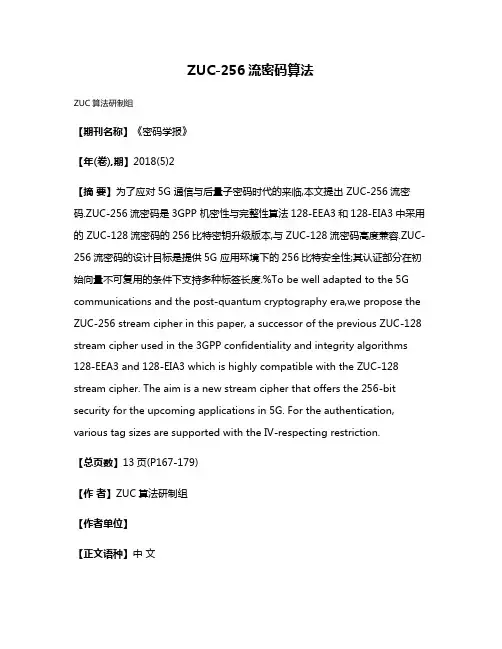
ZUC-256流密码算法ZUC算法研制组【期刊名称】《密码学报》【年(卷),期】2018(5)2【摘要】为了应对5G 通信与后量子密码时代的来临,本文提出 ZUC-256流密码.ZUC-256流密码是3GPP 机密性与完整性算法128-EEA3和128-EIA3中采用的 ZUC-128流密码的256比特密钥升级版本,与 ZUC-128流密码高度兼容.ZUC-256流密码的设计目标是提供5G 应用环境下的256比特安全性;其认证部分在初始向量不可复用的条件下支持多种标签长度.%To be well adapted to the 5G communications and the post-quantum cryptography era,we propose the ZUC-256 stream cipher in this paper, a successor of the previous ZUC-128 stream cipher used in the 3GPP confidentiality and integrity algorithms 128-EEA3 and 128-EIA3 which is highly compatible with the ZUC-128 stream cipher. The aim is a new stream cipher that offers the 256-bit security for the upcoming applications in 5G. For the authentication, various tag sizes are supported with the IV-respecting restriction.【总页数】13页(P167-179)【作者】ZUC算法研制组【作者单位】【正文语种】中文【中图分类】TP309.7【相关文献】1.一种面向RFID的超轻量级流密码算法 [J], 夏文涛; 潘森杉; 王良民2.ZUC-256流密码的猜测决定攻击 [J], 王梓宇; 毛明; 张艳硕3.基于拉丁方的流密码算法设计与仿真 [J], 李熙;田传俊4.基于拉丁方与时变符号混沌系统的流密码算法设计 [J], 唐文君;田传俊5.流密码算法、架构与硬件实现研究 [J], 赵石磊;刘玲;黄海;徐江;刘志伟;于斌因版权原因,仅展示原文概要,查看原文内容请购买。
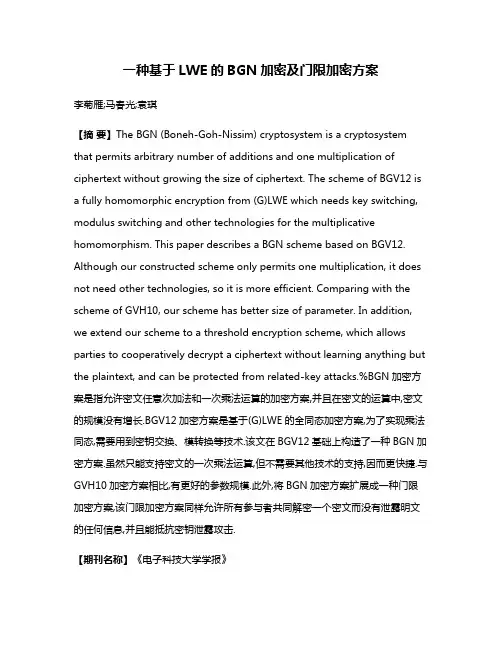
一种基于LWE的BGN加密及门限加密方案李菊雁;马春光;袁琪【摘要】The BGN (Boneh-Goh-Nissim) cryptosystem is a cryptosystem that permits arbitrary number of additions and one multiplication of ciphertext without growing the size of ciphertext. The scheme of BGV12 is a fully homomorphic encryption from (G)LWE which needs key switching, modulus switching and other technologies for the multiplicative homomorphism. This paper describes a BGN scheme based on BGV12. Although our constructed scheme only permits one multiplication, it does not need other technologies, so it is more efficient. Comparing with the scheme of GVH10, our scheme has better size of parameter. In addition, we extend our scheme to a threshold encryption scheme, which allows parties to cooperatively decrypt a ciphertext without learning anything but the plaintext, and can be protected from related-key attacks.%BGN加密方案是指允许密文任意次加法和一次乘法运算的加密方案,并且在密文的运算中,密文的规模没有增长.BGV12加密方案是基于(G)LWE的全同态加密方案,为了实现乘法同态,需要用到密钥交换、模转换等技术.该文在BGV12基础上构造了一种BGN加密方案.虽然只能支持密文的一次乘法运算,但不需要其他技术的支持,因而更快捷.与GVH10加密方案相比,有更好的参数规模.此外,将BGN加密方案扩展成一种门限加密方案,该门限加密方案同样允许所有参与者共同解密一个密文而没有泄露明文的任何信息,并且能抵抗密钥泄露攻击.【期刊名称】《电子科技大学学报》【年(卷),期】2018(047)001【总页数】5页(P95-98,111)【关键词】BGN加密;密钥同态;LWE问题;门限加密【作者】李菊雁;马春光;袁琪【作者单位】哈尔滨工程大学计算机科学与技术学院哈尔滨 150001;哈尔滨工程大学计算机科学与技术学院哈尔滨 150001;中国科学院信息工程研究所信息安全国家重点实验室北京西城区 100093;哈尔滨工程大学计算机科学与技术学院哈尔滨 150001;齐齐哈尔大学通信与电子工程学院黑龙江齐齐哈尔 161006【正文语种】中文【中图分类】TN918基于容错学习(learning with error problem, LWE)的密码是一类备受关注的抗量子计算攻击的公钥密码体制[1]。
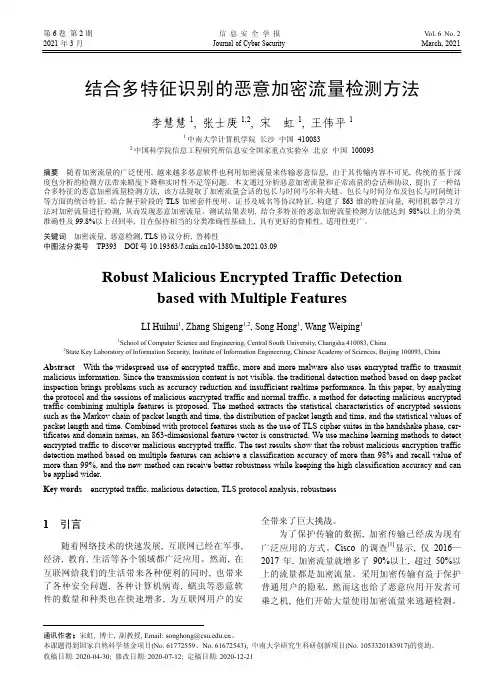
第6卷 第2期 信 息 安 全 学 报V ol. 6No. 22021年3月Journal of Cyber Security March, 2021通讯作者: 宋虹, 博士, 副教授, Email: ****************.cn 。
本课题得到国家自然科学基金项目(No. 61772559、No. 61672543), 中南大学研究生科研创新项目(No. 1053320183917)的资助。
收稿日期: 2020-04-30; 修改日期: 2020-07-12; 定稿日期: 2020-12-21结合多特征识别的恶意加密流量检测方法李慧慧1, 张士庚1,2, 宋 虹1, 王伟平11中南大学计算机学院 长沙 中国 4100832中国科学院信息工程研究所信息安全国家重点实验室 北京 中国 100093摘要 随着加密流量的广泛使用, 越来越多恶意软件也利用加密流量来传输恶意信息, 由于其传输内容不可见, 传统的基于深度包分析的检测方法带来精度下降和实时性不足等问题。
本文通过分析恶意加密流量和正常流量的会话和协议, 提出了一种结合多特征的恶意加密流量检测方法, 该方法提取了加密流量会话的包长与时间马尔科夫链、包长与时间分布及包长与时间统计等方面的统计特征, 结合握手阶段的TLS 加密套件使用、证书及域名等协议特征, 构建了863维的特征向量, 利用机器学习方法对加密流量进行检测, 从而发现恶意加密流量。
测试结果表明, 结合多特征的恶意加密流量检测方法能达到98%以上的分类准确性及99.8%以上召回率, 且在保持相当的分类准确性基础上, 具有更好的鲁棒性, 适用性更广。
关键词 加密流量, 恶意检测, TLS 协议分析, 鲁棒性中图法分类号 TP393 DOI 号10.19363/10-1380/tn.2021.03.09Robust Malicious Encrypted Traffic Detectionbased with Multiple FeaturesLI Huihui 1, Zhang Shigeng 1,2, Song Hong 1, Wang Weiping 11School of Computer Science and Engineering, Central South University, Changsha 410083, China2State Key Laboratory of Information Security, Institute of Information Engineering, Chinese Academy of Sciences, Beijing 100093, ChinaAbstract With the widespread use of encrypted traffic, more and more malware also uses encrypted traffic to transmit malicious information. Since the transmission content is not visible, the traditional detection method based on deep packet inspection brings problems such as accuracy reduction and insufficient realtime performance. In this paper, by analyzing the protocol and the sessions of malicious encrypted traffic and normal traffic, a method for detecting malicious encrypted traffic combining multiple features is proposed. The method extracts the statistical characteristics of encrypted sessions such as the Markov chain of packet length and time, the distribution of packet length and time, and the statistical values of packet length and time. Combined with protocol features such as the use of TLS cipher suites in the handshake phase, cer-tificates and domain names, an 863-dimensional feature vector is constructed. We use machine learning methods to detect encrypted traffic to discover malicious encrypted traffic. The test results show that the robust malicious encryption traffic detection method based on multiple features can achieve a classification accuracy of more than 98% and recall value of more than 99%, and the new method can receive better robustness while keeping the high classification accuracy and can be applied wider.Key words encrypted traffic, malicious detection, TLS protocol analysis, robustness1 引言随着网络技术的快速发展, 互联网已经在军事, 经济, 教育, 生活等各个领域都广泛应用。
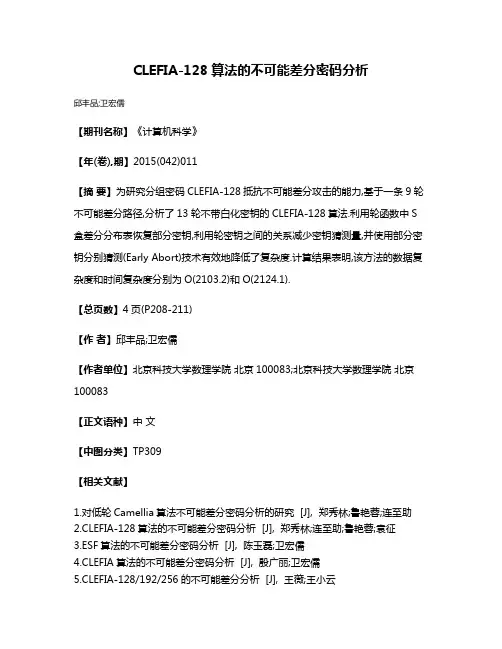
CLEFIA-128算法的不可能差分密码分析
邱丰品;卫宏儒
【期刊名称】《计算机科学》
【年(卷),期】2015(042)011
【摘 要】为研究分组密码CLEFIA-128抵抗不可能差分攻击的能力,基于一条9轮
不可能差分路径,分析了13轮不带白化密钥的CLEFIA-128算法.利用轮函数中S
盒差分分布表恢复部分密钥,利用轮密钥之间的关系减少密钥猜测量,并使用部分密
钥分别猜测(Early Abort)技术有效地降低了复杂度.计算结果表明,该方法的数据复
杂度和时间复杂度分别为O(2103.2)和O(2124.1).
【总页数】4页(P208-211)
【作 者】邱丰品;卫宏儒
【作者单位】北京科技大学数理学院 北京100083;北京科技大学数理学院 北京
100083
【正文语种】中 文
【中图分类】TP309
【相关文献】
1.对低轮Camellia算法不可能差分密码分析的研究 [J], 郑秀林;鲁艳蓉;连至助
2.CLEFIA-128算法的不可能差分密码分析 [J], 郑秀林;连至助;鲁艳蓉;袁征
3.ESF算法的不可能差分密码分析 [J], 陈玉磊;卫宏儒
4.CLEFIA算法的不可能差分密码分析 [J], 殷广丽;卫宏儒
5.CLEFIA-128/192/256的不可能差分分析 [J], 王薇;王小云
因版权原因,仅展示原文概要,查看原文内容请购买
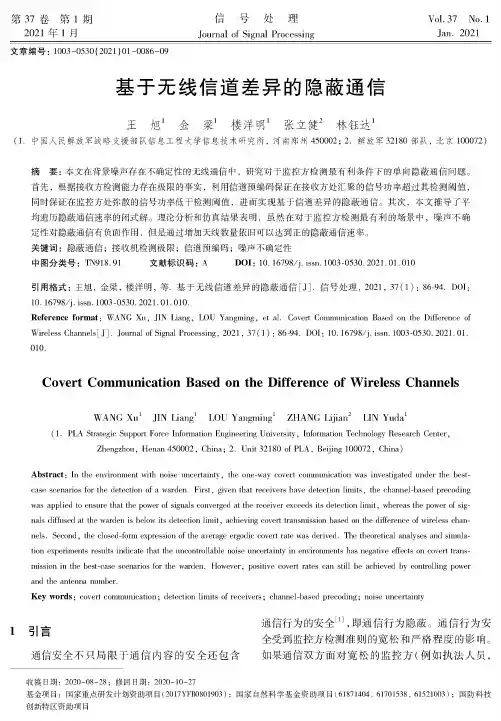
Vol. 37 No. 1Jan72021第 37 卷#第 1 期2021年1月信号处理Journal of Signal Processing文章编号:1003-0530(2021)01-0086-09基于无线信道差异的隐蔽通信王旭1金梁1楼洋明1张立健2林钰达1(1.中国人民解放军战略支援部队信息工程大学信息技术研究所,河南郑州450002 ; 2.解放军32180部队,北京100072)摘要:本文在背景噪声存在不确定性的无线通信中,研究对于监控方检测最有利条件下的单向隐蔽通信问题。
首先,根据接收方检测能力存在极限的事实,利用信道预编码保证在接收方处汇聚的信号功率超过其检测阈值, 同时保证在监控方处弥散的信号功率低于检测阈值,进而实现基于信道差异的隐蔽通信。
其次,本文推导了平 均遍历隐蔽通信速率的闭式解。
理论分析和仿真结果表明,虽然在对于监控方检测最有利的场景中,噪声不确定性对隐蔽通信有负面作用,但是通过增加天线数量依旧可以达到正的隐蔽通信速率。
关键词:隐蔽通信;接收机检测极限;信道预编码;噪声不确定性中图分类号:TN918.91 文献标识码:A DOI : 10. 16798/j. issn. 1003-0530.2021.01.010引用格式:王旭,金梁,楼洋明,等.基于无线信道差异的隐蔽通信[J ].信号处理,2021,37(1 ): 86-94. DON10. 16798/j. issn. 1003-0530.2021.01.010.Reference format: WANG Xu , JIN Liang ,LOU Yangming , el al. Covert Communication Based on the DiPerenco ofWireles Channels ' J ]. Journal of Signal Processing ,2021,37(1) : 86-94. DOI : 10. 16798/j. issn. 1003-0530. 2021.01.010.Covert Communication Baser on the Differeece of Wireless ChannelsWANG Xu 1 JIN Liang 1 LOU Yangming 1 ZHANG Lijian 2 LIN Yuda 1(1. PLA Swategic Support Force Information Engineering University ,Information Technology Research Center ,Zhengzhou ,Henan 450002,China ; 2. Unit 32180 of PLA ,Beijing 100072,China)Abstract : In the environment with noise uncertainty ,the one-way covert communication was investigated under the best-casescenaeoosooeihedeiecioon ooawaeden.Foesi , goeen ihaieeceoeeeshaeedeiecioon aomois, ihechannea-based peecodongwas applied to ensure that the power of signals converged al the receiver exceeds its detection limit ,whereas the power of sig-naasdo o used aiihewaeden osbeaowoisdeiecioon aomoi ,achoeeongcoeeeiieansmo s oon based on ihedo o eeenceoowoeeae s chan- nels. Second ,the closed-form expression of the average ergodic covert rate was derived. The theore/cd analyses and simula tion experiments results indicate that the uncontrollable noise uncertainty in environments has negative e/ects on covert Wans- mo s oon on ihebesi-casescenaeoosooeihewaeden.Howeeee ,posoioeecoeeeieaiescan sio a beachoeeed byconieo a ongpowee and iheaniennanumbee.Key wo —s : covert communication ; detection limits of receivers ; channel-based precoding ; noise uncertainty引言通信行为的安全[1],即通信行为隐蔽。
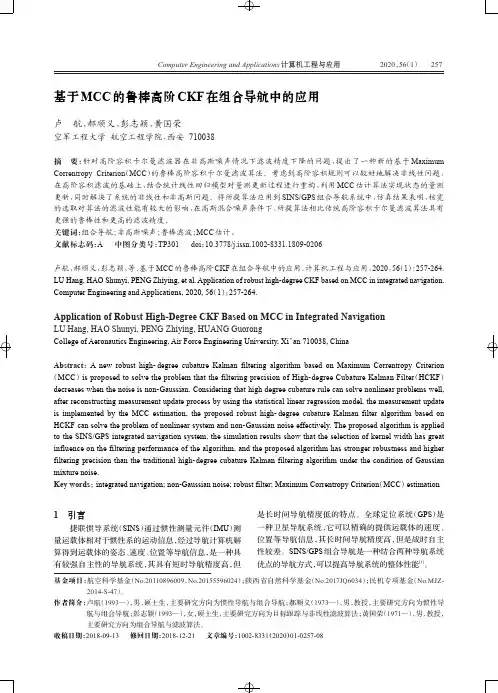
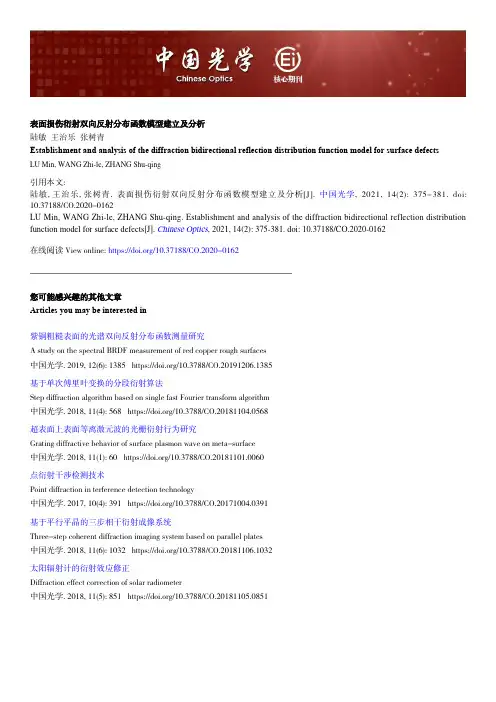
Reconstructing the Nonlinear Filter Function of LILI-128 Stream Cipher Based on Complexity
Xiangao Huang1 Wei Huang2 Xiaozhou Liu 3 Chao Wang4 Zhu jing Wang5 Tao Wang11College of Engineering, Shantou University, Shantou, 515063, China
Email: xghuang@stu.edu.cn 2 Xian Electron Technique Research Institute of ZTE, 710061, China 3 School of Electronics and Information Engineering, Xi’ an Jiaotong University,
Xi’an 710049, China 4 College of Information, Chang an University, 710064, China
5 Chongqing Communication institute, chongqing, 400035, China
Abstract: In this letter we assert that we have reconstructed the nonlinear filter function of LILI-128 stream cipher on IBM notebook PC using MATLAB. Our reconstruction need approximately13122~2bits and the attack consumes 5825.016 sec (using tic and toc sentences of MATLAB) or 5825.016/3600=1.6181hours. We got the expression of the nonlinear filter function of Lili-128 which has 46 items from liner items to nonlinear items based on complexity, the phase space reconstruction, Clustering and nonlinear prediction. We have verified our reconstruction result correctness by simulating the overview of Lili-128 keystream generators using our getting and implement designers’ reference module of the Lili-128 stream cipher, and two methods produce the same synchronous keystream sequence on same initial state, so that our research work proves that the nonlinear filter function of LILI-128 stream cipher is successfully reconstructed. df
df
Keywords: Stream Cipher; LILI-128; reconstruction; . 1. Introduction LILI-128 stream cipher is designed by Dawson, Clark, Golic, Millan, Penna and Simpson[1], and submitted to NESSIE as a candidate cipher. Because the keystream sequence are a long period around 2128, high linear complexity which is conjectured to be at least 268, and good statistics regarding the distribution of zeroes and ones, so designers assert that the LILI-128 keystream generator can resist currently known styles of attack. Some methods[2-5] of breaking it have been proposed, since LILI-128 stream cipher was publicized in 2000. The methods have already been shown that attack the LILI-128 stream cipher more efficiently than an exhaustive search for its secret key. However most of the attack methods consider only the
1complexity of time or memory for search for its secret key. For example, Time- Memory Tradeoff Attack[2] needs approximately 246 bits, and Correlation Attack[3] needs approximately about 223 bits. While Algebraic Attack [4] needs approximately 218 bits. Even a new attack method[5] requires a mere 27 bits of keystream. But this attack methods needs large memory and computations. For example, the paper[5] needs 299.1 computations. In 2005, designers summarize all published styles of attack on the LILI-II stream cipher, and assert that LILI-II remains unbroken[6]. They encourage further analysis of the LILI-II stream cipher. Section Ⅱ of this paper describes the structure of LILI-128. Section Ⅲ give the expression of the nonlinear filter functiondf. Section Ⅳ verifies the correctness of the expression of the nonlinear filter functiondf. We give the conclusion of this paper in Section Ⅴ.
Ⅱ. The structure of LILI-128 The structure of the LILI-128 keystream generators is illustrated in Figure 1. The generator can be divided into two subsystems based on the functions they perform: the clock control subsystem and data generation subsystem. The clock control subsystem produces an integer sequence that is used to control the clocking of the second subsystem. The feedback polynomial of the LFSRc is chosen to be the primitive polynomial
1)(214151731333539++++++++=xxxxxxxxxGc (1) Since is primitive, the LFSR)(xGcc produces a maximum-length sequence of period. The function takes two bits as input and produced an integer , such that 12
39−=cPcf
kc{}4,3,2,1∈kc. The value of kc is calculated as
.1,12),(2121≥++==kyyyyfcck (2) The LFSRd is clocked by at least once and at most four times between the output of consecutive bits. The feedback polynomial of LFSRkcd is given as follows: 1)(39425355808389++++++++=xxxxxxxxxGd (3)
Since is a primitive polynomial, a period of )(xGd1289− at maximum is guaranteed for LFSRd output sequence. The contents of 10 different stages of LFSRd
are input to a nonlinear filter function. The output of is the keystream
sequence. dfdf
2